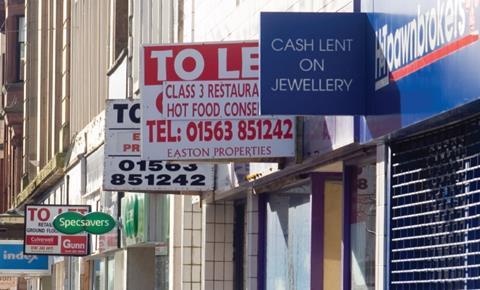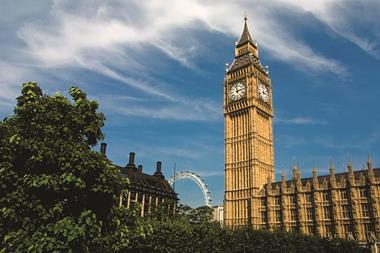Steep increases in business rates are hurting retailers in the tough trading climate. Tiffany Holland reports on Fair Rates for Retail, our campaign for a rates freeze next year.

Business rates increases over the past two years have dealt damaging blows to the retail sector, which is already struggling in a difficult economy and when consumer confidence is stubbornly low.
Retail is the largest contributor to the Treasury’s business rates pot, paying a massive 28% of the total. And the burden is one of the biggest barriers to growth in the sector.
That is why, in partnership with the British Retail Consortium (BRC) and backed by top retailers such as Boots, Asda, Waitrose and Debenhams, Retail Week is calling on the Government to deliver Fair Rates for Retail.
A rates freeze next year and changing the way they are calculated to a less volatile measure than RPI will alleviate the burden. At present, retailers face a potential £200m in extra costs if an increase goes ahead next year.
Kingfisher group chief executive and BRC chairman Ian Cheshire has written to the Chancellor to lay out his concerns about business rates.
He told Retail Week that Kingfisher’s bill had increased significantly and pointed out business rates are higher than corporation tax. “It’s well worth trying to push for a freeze,” he says. “The BRC spoke to the Treasury last year about similar concerns but I think this year we’ve got to push a bit harder.”
How retailers are affected by rising rates
The 4.6% increase in 2010 and the 5.6% increase in 2011 have meant retailers have been seriously impacted by escalating costs. Many retailers maintain store growth plans have been stunted as a result, and some existing stores have become unviable as trading locations.
Alliance Boots chief executive for health and beauty Alex Gourlay supports this view. “The current rates system is a substantial contributor to lower investment and growth in high streets,” he says.
The Entertainer managing director Gary Grant has had to rethink new store openings because of high rates, while staff salaries have also been affected. “Business rates are a barrier to expansion. We’ve had a 5.6% increase in rates but not in turnover, which has squeezed salary increases and stopped us doing things we usually would,” he explains.
Now, as the October 16 date for the September RPI inflation figure to be revealed looms, which will help determine the new business rate level, retailers are concerned another big rise could wreck further plans, as they face a likely bill increase of £200m next year on top of the £500m extra they have been forced to pay since 2010.
Tom Ironside, director of business and regulation at the BRC, says: “Already retailers pay the largest proportion of business rates in any sector at a time when trading is far from robust. You only have to look at the scale of the number involved to see business rates must be a key concern for the sector at present.”
Debenhams chief executive Michael Sharp adds: “The increase in business rates over the past year has added substantially to the cost of operating, at a time when the role [stores] play in those communities is more important than ever.”
Online retailers have no such problem, however, because, without stores, their business rates bill only affects warehousing and distribution centres.
It is a blow to bricks-and-mortar retailers, which are already fighting to attract shoppers back to high streets.
Retailers believe the method used to calculate business rates is unfair. They are calculated based on September’s RPI level. Ironside explains: “The calculation method is set out in legislation that states business rates can be increased up to the level of September’s RPI, which of course, it always is.”
Retailers believe the apparent randomness of basing rates on this number creates an unjust system. Instead, inflation across the Consumer Prices Index (CPI) would provide a more consistent, predictable increase, particularly if it is based on a 12-month average. Morrisons chief executive Dalton Phillips says: “Setting business rates on a single month’s RPI is completely arbitrary, yet it impacts investment and jobs all year round. We’ve got to get a sensible new approach to replace this rates lottery which is damaging confidence and hampering growth.”
Law firm Addleshaw Goddard associate Serena Glover agrees: “If you register it to CPI rather than RPI the increase would be less volatile and in my opinion would be a reasonable approach.”
Independent retailers can be especially hard hit. Paul Turner-Mitchell, director of indie fashion retailer 25 Ten Boutique, says it is unjust to base the rates on September inflation levels. “Last year’s 5.6% inflation was abnormally high,” he says. He points out that inflation this year has not been on the levels of last September. “The Government got a huge windfall,” he adds.
The burden has been enough to put some independents out of business, says retail expert Clare Rayner, founder of consultancy Retail Acumen. She says: “It certainly has stunted growth. Some retailers have had to let staff go and are working in the store themselves to save on salaries in order to make up the rates payments at a time when sales are slow.
“Others have paused recruitment – so it’s having a detrimental effect on employment levels for starters. Obviously no retailer is going to open new stores at a time of such uncertainty, and so the increase in rates has been very detrimental and particularly at the micro end of the retail spectrum where one additional store could mean a business doubles in size, turnover and staff numbers.”
The effect on vacancy levels

Rates increases have led to significant property problems for retailers, and some were left with unsustainable stores. Clinton Cards and Peacocks are two major retailers that collapsed into administration, due in part to their large and unsustainable store portfolio. Both retailers were rescued and now trade from slimmed down estates.
Addleshaw Goddard partner Andrew Shufflebotham explains: “A lot of retailers are continuing to struggle with their estate and they are trying to work out what to do with their property. If you offered to take the 30% of property that was underperforming at their business they would bite your hand off.
“This is creating a polarisation in the market. Before, retailers would slide down the property scale taking different types of sites. Now, retailers only want good space. Although this remains expensive and highly competitive, the stores are still profitable and offset the high rates.”
And while landlords are responding to retailers’ concerns, there is a limit to their ability to ease cost pressures.
Shufflebotham says: “One of the ways landlords keep retailers is by dropping rents, which is putting extra pressure on them [property owners]. But they can only move so far because they have the mortgage and interest to cover.”
Indeed, many retailers report that in some locations the rates charged on a property are above and beyond the rent being charged, when it should be the reverse.
CBRE’s Jonathan De Mello says: “Landlords will bend over backwards to get their retailers in a store, but rates can be a deal-breaker in some cases. This is happening more and more.” Alliance Boots chief executive for health and beauty Alex Gourlay says: “Business rates now constitute the largest proportion of occupational costs in many locations, even greater than the actual rent paid.”
This distortion of the market has led to some retailers turning their backs on properties where they could have opened a new store. It means some sites fall empty, adding to the vacancy rate in the UK, which currently stands at a record high of 14.6% according to the Local Data Company.
The Entertainer managing director Gary Grant says: “The high street needs to get back on its feet, we need to bring premises back to life, but business rates are a millstone around retailers’ necks. They are so high that in the end we have walked away from opening many shops.”
Indeed, even when a retailer has made the difficult decision to close a store, potentially due to the cost, it must still pay the rates charged on a vacant property after the Government abolished Empty Property Rates Relief. This could be seen as taking further money away from investment in the retail market.
Rateable values

Even if business rates are frozen next year, rateable values, or open market annual rent values, are also causing exceptional costs for retailers.
Renewed every five years, the rateable values set by Government are used to calculate the level of business rates paid to Government.
The last valuation took place in 2010, using 2008’s levels. BRC director of business and regulation Tom Ironside believes that time lag results in distortion.
The next valuation does not take place until 2015, so retailers will be measured against the 2008 levels until that time.
Retailers have also often found if they question Government on valuations, they are left waiting a long time for an answer.
Ironside says: “The Government needs to make valuations that are as accurate as possible and it seems there are perceptions in the past that this has not always been the case.
You can tell this by the number of appeals that sit in the database. The appeals process must be streamlined to be as responsible as possible and any errors must be corrected as quickly as possible.”
Government action
The Government commissioned self-styled retail guru Mary Portas to recommend ways to revive town centres. Tackling onerous business rates was part of her list of recommendations. However, the Government’s response was to offer businesses a two-year deferral rather than a real ease in the cost burden.

Chancellor George Osborne is also understood to have set up a working group to tackle business rates as a whole, which includes the way they are calculated, but so far there has been no update as to the progress of this work.
Addleshaw Goddard partner Andrew Shufflebotham believes this year the Government might be more responsive to lobbying because it is getting closer to the next general election. He says: “Clearly every bit of money spent retailers could do with. Quality retailers want to invest online and in mobile commerce. The platforms are expensive and are constantly changing. If retailers don’t keep up with the digital world they might fall off the cliff.
“If they were given a freeze on rates for the year it would allow them to refurbish their store estate, rebalance their portfolio, or invest in digital platforms.”
Retail Week and the BRC hope that with as much retail support as possible, the Government will sit up and listen, making 2013 a better year for retail.


























1 Reader's comment